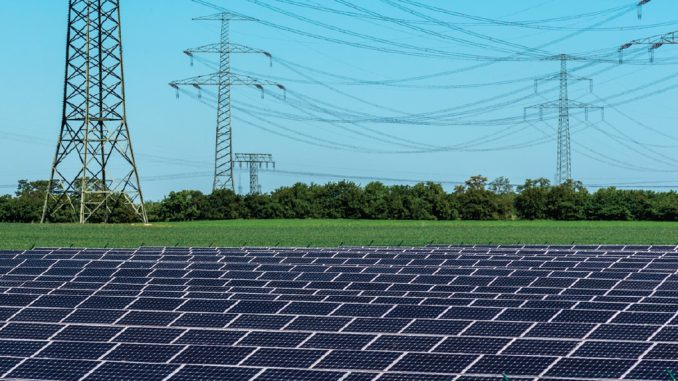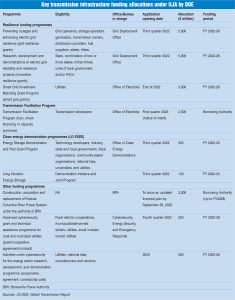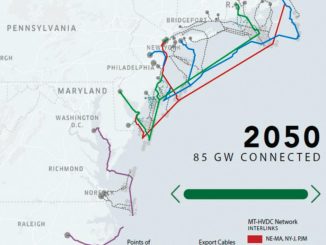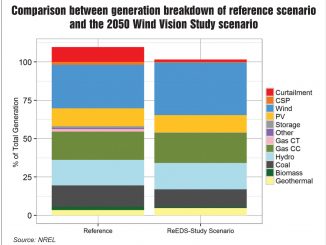
In 2021, the Biden Administration set ambitious climate goals of achieving 100 per cent clean electricity by 2035 and net zero emissions by 2050. This has put the spotlight on the urgent need for rebuilding and modernising the country’s ageing electricity transmission grid, which is considered critical for integrating large-scale clean energy as well as withstanding climate change impacts. To support these goals, huge dedicated federal funding allocations have been made for grid modernisation under the Bipartisan Infrastructure Law (BIL), enacted as the Infrastructure Investment and Jobs Act (IIJA) in November 2021.
The IIJA-proposed funding includes new federal investment totalling $65 billion dedicated to power and grids. Particularly, it has authorisation of over $28.8 billion to upgrade the power infrastructure, including by building thousands of miles of new, resilient transmission lines to facilitate the expansion of renewable energy.
The US Department of Energy (DOE) has launched several programmes to implement the key provisions of the law in the electricity sector. At the start of 2022, the DOE launched the “Building a Better Grid” initiative to catalyse the nationwide development of new and upgraded, high capacity transmission lines with plans to deploy over $20 billion in federal financing tools.
Over the past few months, the DOE has released several notices of intent (NOIs) and requests for information (RFIs) prior to opening applications for funding under the various BIL programmes. For the transmission sector, in particular, the DOE released an RFI for the $2.3 billion formula grant funding programme for states and tribal nations for grid modernisation in April 2022 and an RFI for the $2.5 billion Transmission Facilitation Program (TFP) in May 2022. On July 6, 2022, the DOE opened applications for the former programme.
In the clean energy sphere, the DOE released the RFI for the $505 million Long Duration Energy Storage for Everyone, Everywhere (LD ESEE) programme to commercialise new technologies that increase grid reliability and enable large-scale clean energy integration. Further, it launched the Interconnection Innovation e-Xchange (i2X), a new BIL-funded partnership, that brings together grid operators, utilities, state and tribal governments, clean energy developers, energy justice organisations, and other stakeholders to connect more clean energy to the US power grid by solving some of the challenges facing the power industry.
PowerLine presents the key features of the DOE programmes under BIL for the transmission sector…
Grid resilience funding programmes
Under BIL, around $8 billion has been allocated for improving grid resilience across three programmes – $5 billion to the “Preventing outages and enhancing electric grid resilience/Hazard hardening” programme or the grid resilience grants under Section 40101 of the law; $5 billion to the “Program upgrading our electric grid and ensuring reliability and resiliency” or innovative resilience grants under Section 40103(b); and $3 billion to “Deployment of technologies to enhance grid flexibility” or smart grid grants under Section 40107.
Under innovative resilience grants, $1,000 million will be available annually for fiscal years 2022 through 2026. States, tribes, local governments and public utility commissions will be eligible to receive grants under this programme. Federal financial assistance will be available to demonstrate innovative approaches to transmission, storage and distribution infrastructure to strengthen and enhance resilience and reliability; and to demonstrate new approaches to enhance regional grid resilience, implemented through states by public and rural electric cooperative entities on a cost-shared basis. Applications for this programme will open in the third quarter of 2022.
Under smart grid grants, $600 million will be appropriated annually for fiscal years 2022 through 2026. Utilities will be able to avail of grants for eligible investments including metering, control and other devices, sensors and software; communications and broadband technologies to support smart grid deployment; technologies and programmes to integrate electric vehicles with the grid; devices and software for buildings support demand flexibility and other smart grid functions; operational fibre and wireless broadband communications networks, enabling data sharing between distribution system components; and advanced transmission technologies, including dynamic line rating, flow control devices, advanced conductors and network topology optimisation, to increase the operational transfer capacity of transmission networks.
The grid resilience grants programme has two provisions – the state, territory and tribes formula grant funding programme and a competitive solicitation for utilities and industry. While the NOI and RFI have already been released for the former programme (worth $2.3 billion), they are expected to be announced shortly for the latter programme.
Formula grant funding programme
The overall formula grant funding amount is spread over five years for fiscal years 2022 through 2026, or about $459 million annually. The states, territories and tribes have to provide 15 per cent cost share, and up to 5 per cent of the funds can be used for technical assistance. In line with the legislation, the DOE will consider five criteria for developing the formula for the programme – population, area, probability of a disruptive event, severity of disruptive events, and expenditure of mitigation efforts.
The states, territories and tribes may further subgrant to eligible entities such as electrical grid operators, energy storage operators, electricity generators, transmission owners and operators, distribution providers and fuel suppliers. An eligible entity that receives a subgrant must match 100 per cent of the amount of the subgrant. There are some exceptions. If the subgrant entity sells 4 TWh of electricity or less per year, the required match will be one-third of the amount awarded to the subgrantee.
Transmission Facilitation Program
The launch of this new programme, with an authorisation of $2.5 billion, is one of the first down payments on over $20 billion of investments under the DOE’s Building a Better Grid Initiative. Essentially, the TFP is an innovative, revolving fund programme that will provide federal support to eligible projects for overcoming financial hurdles. This includes either construction of a new or a replacement transmission line of at least 1,000 MW; upgrade of an existing transmission line or construction of a new transmission line in an existing transmission, transportation or telecommunication infrastructure corridor of at least 500 MW; or the connection of an isolated microgrid to an existing infrastructure corridor located in Alaska, Hawaii or a US territory.
Under the TFP, three financing tools are available – DOE loans; the DOE participation in public-private partnerships (PPPs); and capacity contracts with eligible projects in which the DOE would serve as an “anchor customer”. The DOE can extend loans at a fixed rate, considering current market conditions. Under PPPs, the DOE can participate with eligible companies in designing, developing, constructing, operating, maintaining or owning projects that are either within a national interest electric transmission corridor or are necessary to accommodate an increase in electricity demand across more than one state or transmission planning region.
Through capacity contracts, the DOE will commit to purchasing up to 50 per cent of the maximum capacity of the transmission line for up to 40 years. Thus, DOE can help overcome the financial challenges that often face new transmission programmes or upgrades to existing transmission lines by encouraging and de-risking additional investments. The DOE is planning a phased approach for TFP solicitation starting 2022.

Clean energy programmes
The LD ESEE initiative is a four-year programme (2022-25) to validate new grid-scale long-duration energy storage technologies and enhance the capabilities of customers and communities to integrate grid storage more effectively. Administered through the DOE’s new Office of Clean Energy Demonstrations, the initiative includes four energy storage demonstration programmes – energy storage demonstration projects (Demo Projects), the Energy Storage Pilot Grant Program (Pilot Grants), the Long-Duration Demonstration Initiative (Demo Initiative); and the Joint Program. Under the last, the DOE will collaborate with the Department of Defense (DOD) for long-duration demonstrations on government facilities. An allocation of $355 million has been made for Demo Projects and Pilot Grants, and the remaining $155 million is dedicated to the Demo Initiative and the Joint Program.
The Demo Initiative will prepare a cohort of promising technologies for eventual utility-scale demonstration. The field demonstrations, in particular, are intended at a scale of 100 kW or less and have already been proven at lab scale. Demo Projects aims to help commercialise new energy storage technologies that can power the grid for at least 10 hours and drive down the levellised cost of storage (LCOS) to $0.05 per kWh by 2030. The DOE is required to fund three energy storage demonstration projects by September 30, 2023. The Pilot Grants programme will help overcome the institutional barriers to technology adoption in the marketplace. The initiative aims to lower grid energy storage barriers and support both small-scale behind-the-meter pilots and major utility-scale demonstrations. Some of the eligible uses for Demo Projects are improving the security of critical infrastructure and emergency response systems; improving the reliability of transmission and distribution (T&D) systems; optimising T&D system operation and power quality to defer or avoid the cost of replacing or upgrading electric grid infrastructure; providing ancillary services for grid stability and management; integrating renewable energy resource capacity; improving energy efficiency; and integrating fast charging of electric vehicles.
Long-duration storage facilitates higher levels of renewable energy penetration without having to overbuild on the generation and transmission sides. Besides lithium-ion batteries, which currently dominate the energy storage market, other long-duration candidates include sodium-ion batteries, vanadium flow batteries and fuel cells powered by renewable gas and green hydrogen.
In a related development, the DOE’s Solar Energy Technologies Office and Wind Energy Technologies Office launched the i2X partnership to help reduce wait times for clean energy sources in interconnection queues and lower costs to connect to the grid. i2X is supported by the Pacific Northwest National Laboratory, the National Renewable Energy Laboratory, and the Lawrence Berkeley National Laboratory.
Conclusion
The US has embarked on an extensive journey to renew its transmission system and deploy new technologies to meet the country’s energy transition goals. Sizeable federal funding has been dedicated for this purpose under BIL. The DOE is making concerted efforts to put in place the frameworks for disbursing the funds to deserving candidates. However, to realise this grand vision, effective and timely implementation is the key. n



